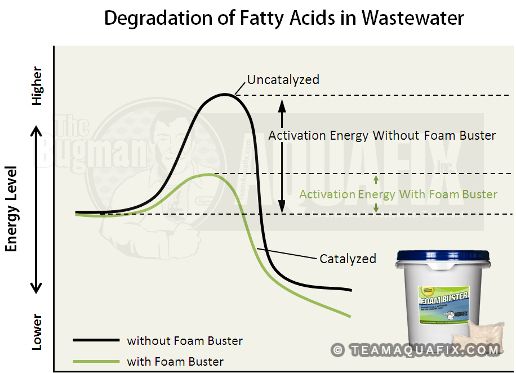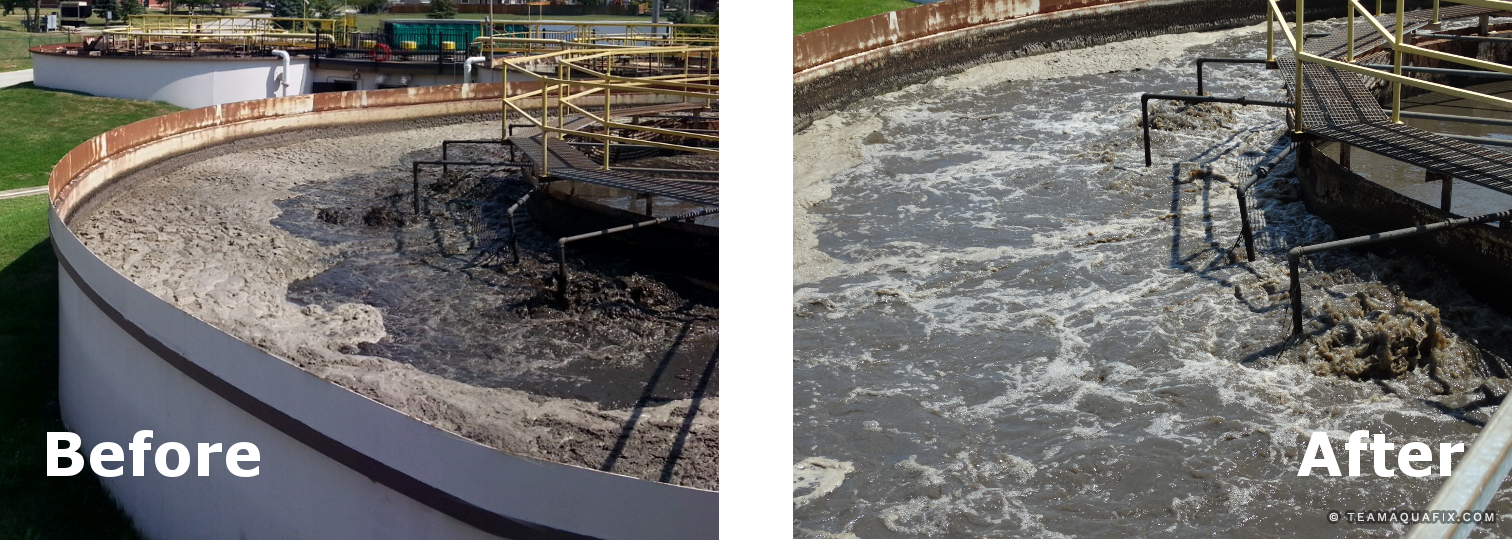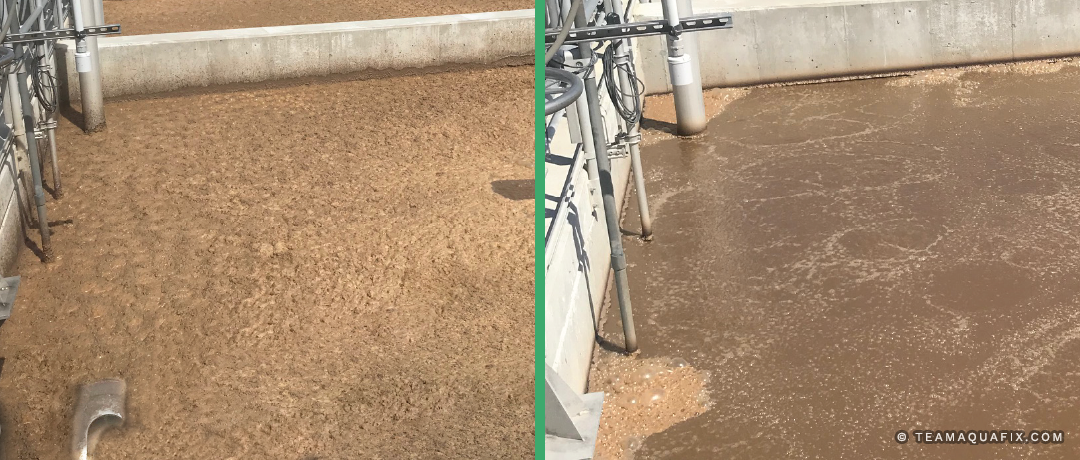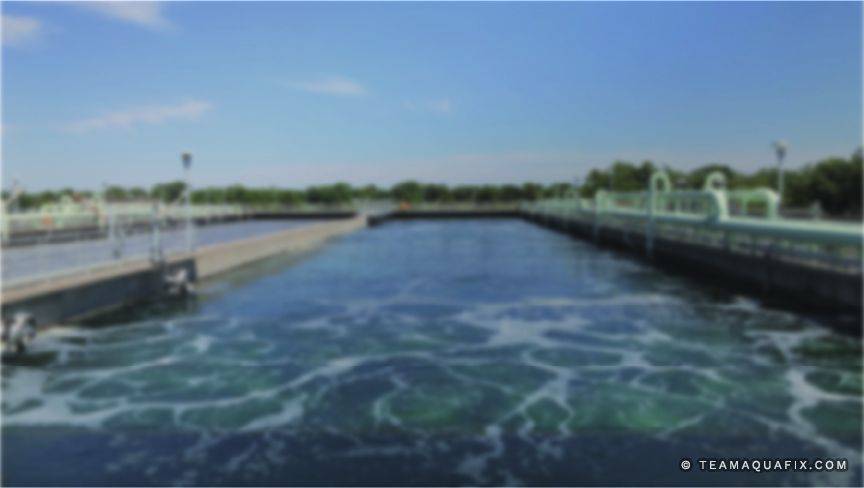Product Resources
PDF Downloads: Product info, SDS, and white papers
Foam Buster
Immediate Breakdown of Fat, Oil, and Grease
- Digests short chain fatty acids and the by-products of grease degradation
- Provides key nutrients and stimulants
- Safe and easy to use
* Get to the root cause of your foaming. Click here for our Microanalysis and Filament Origins testing.
$340.00 – $360.00
Product Info
Foam Buster is a blend of specialized proteins, free amino acids, and micronutrients which stimulate the floc-forming bacteria to degrade grease, emulsions, and helps them to outcompete the filaments which cause foaming. Chlorinating can only provide short term relief, and often only fragments the filaments, leading to worse foaming issues down the road. Foam Buster addresses the underlying cause of foaming.
Foaming filaments like Nocardia-like organisms and Microthrix parvicella use fatty acids to produce a buoyant cell wall. Foam Buster programs your wastewaters plant’s naturally occurring bacteria to consume these fatty acids. Foam Buster’s vitamins enable certain cellular functions to accomplish this task. Once the degradation of FOG and fatty acids improves, these troublesome filaments cannot survive on the dwindling food supply.
Foam Buster is effective in the oxidation ditches, activated sludge plants, SBRs, extended aeration wastewater treatment plants, and aerobic digesters. All these areas can be infiltrated by foam-causing, F.O.G.-hungry filaments like Microthrix parvicella, Nocardia, and Type 1863. Foam Buster also works well on the bulking filament Type 0092.
Most bacteria in wastewater plants are unmotivated and listless. Part of Foam Buster’s micronutrient blend is formulated to give the filament-degrading bacteria extra boosts of energy that allow them to degrade the filaments faster than they can reproduce thus getting rid of foam. As the graph shows, Foam  Buster allows wastewater bacteria to degrade filaments while contributing a much lower amount of their own energy.
Buster allows wastewater bacteria to degrade filaments while contributing a much lower amount of their own energy.
Foam Buster supports filament degradation in more ways than energy. Its formula also contains nutrients specifically needed by the bacteria to create certain foam-busting biocatalysts. A bacon grease molecule is different from a butter molecule is different from a filament molecule, and Foam Buster provides the right array of micronutrient ingredients to allow the bacteria to produce the specialized recipes for biocatalysts to attack these different molecules.
A lot of time when a wastewater plant gets foam they will use a chemical defoamer or an anti-foam to knock it down. Chemical defoamers work by covering up the problem for a period of time. In addition, chemical defoamers can cause sludge bulking issues, nitrifier toxicity, and are limited in that they do not control Nocardia or surfactant foams. Silica anti-foamers break down into siloxanes which corrode combustion engines. Neither type of product truly addresses the root cause of the problem.
Dose Rates
Product Pairings
Applications and Benefits
- Oxidation ditches
- Sequencing batch reactors (SBRs)
- Extended aeration wastewater treatment plants
- Aerobic digesters
- Reduces and eliminates foam
- Reduces sludge and scum production
- Eliminates negative impacts from incoming fat, oil, and grease
- Improves settling
- Increases good bacterial populations
Case Studies
Nocardia Foam

Challenge
A wastewater treatment plant on the south side of Chicago had an extensive foaming issue caused by the Nocardia filament. All the aeration basins were completely covered and the foam even found its way into the center walls of the clarifier.
1.1 MGD activated sludge municipal treatment plant incoming BOD: 140-160 ppm incoming ammonia: 15-20 ppm.
In addition to the foaming, the plant received exceptionally high spikes of ammonia during the weekends. These spikes would reach up to 60 ppm.
Solution
The operators began applying Foam Buster and Qwik-Zyme L to improve the cold weather degradation of surfactants, grease, and long-chain fatty acids, all which are nutrients for Nocardia.
Results
By the 30th day of the application, 5% of the foam cleared up to 75%. The operators continued a maintenance application to fully clear the plant. By fully degrading the grease and fatty acids, more ammonia and nitrogen was consumed, thus stabilizing the weekend ammonia spikes.
Another piece to the puzzle: This plant’s operator got a tip from a nearby neighbor about suspicious activity. After putting two and two together the operator notified the authorities. It turns out, in this nice community, a resident was producing methamphetamine. As soon as this meth lab was shut down, the wastewater plant stop receiving ammonia spikes. Aquafix was able to help out with the spikes, but the production of methamphetamine will send very high amounts of ammonia and other chemicals to your plant. It is unfortunate, but highly important to keep a watchful eye.
Oxidation Ditch
Challenge
A wastewater plant in Western Pennsylvania has a flow rate of 3 million gallons per day. During the winter months they routinely encounter problems with foam.
Solution
March 1, 2011 they began adding 20 lb. of Foam Buster per day.
Results
3 weeks later: The foam was gone and the temperature of the aeration basins was 75°F.





Village of Westfield (WI) –
Began using these two products (Foam Buster & Qwik-Zyme L) one month ago to help reduce nocardia. Though I still need to waste more at the plant, I am seeing a benefit in phosphorous reduction it appears based on data.
Jessie F. (LA) –
This really helps prevent floatable derbs/foam on water.
Steven C. (PA) –
Had a serious issue with foaming after a large upset. I started dosing the aeration process with foam buster and within about 25- 28 days started seeing an impact. Within two months, the foam was completely gone. I paired this with Qwik zyme L for the added knockout punch. It is very convenient to use. Just toss the water soluble bags in the head of the process and walk away. I love when things are made easy.
Angel V. (NM) –
Great product for stopping massive buildup of foam. Even the toughest buildup of foam would disintegrate when foam buster was introduced. All in all great product as well as there other products.
Kyle M. (CA) –
Our wastewater system was overflowing due to surfactants in the EQ and I decided to try the Qwikzyme L and Foam Buster based on the product descriptions on the website. Within 24 hours, the foam had been knocked down to manageable levels and within a week, it is completely gone. The Aquafix has emailed and called to be sure everything worked and made other suggestions to prevent future issues. I’m very impressed and will continue buying their products and utilize their expertise to manage our system.
Stephen R. (PA) –
Works as advertised, the foam buster worked in minutes.
Scott K. (OH) –
We have been fighting Foam in our Anaerobic Digesters for a couple months. I bought Foam Buster and have been using it for a few weeks and our foam has gone down a little. Going to continue to use it for a couple more weeks and see where we are at. Great company, easy orders, and fast delivery!